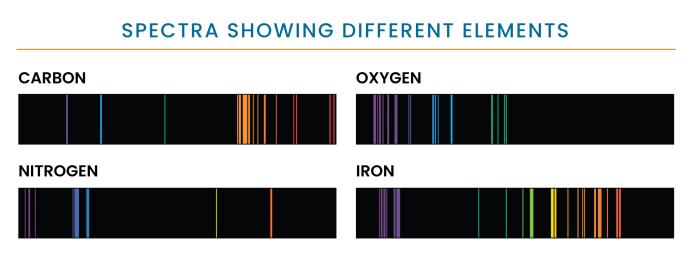When people first used telescopes, they looked through them and made drawings or notes of what they saw. Then cameras were invented, and we could save this information as a picture instead. Today, we have many different types of instruments, like cameras, to measure what we see.
We can place instruments on telescopes in different places. Some are in front of the main mirror, and others use small mirrors to bounce light around. This means they can be placed on the side or bottom of the telescope. Some telescopes have instruments that sit on a spinning wheel behind the main mirror, allowing us to switch between them quickly.
The most common type of instrument is a camera. These look at visible or infrared light from Earth, but we also put them on space telescopes to see all kinds of light. Modern cameras let us see more detail in objects. We can keep the shutter on the camera open for longer, collecting more light, which allows us to see fainter objects in space.
Spectrographs are also found on most telescopes. They split the light into its different colours and can look at what an object is made of by looking for elements that absorb bits of light.

- Cameras
CCD Cameras are very sensitive digital cameras. They are built around a Charge-Coupled Device (CCD) to count photons (packets of light) falling into the millions of tiny buckets (or pixels) on its surface. The CCD then reads, stores and uses these photons to recreate the image the camera was looking at. They make digital images, which can be moved around easily as a special file.
Image CreditThis work by Sphl is licensed under Creative Commons Attribution Share Alike 4.0 International
CreditThis work by Sphl is licensed under Creative Commons Attribution Share Alike 4.0 InternationalA CCD image sensor that is about 2/3 inches in size The electronic chips inside CCD cameras are like those in digital cameras. One of the main differences is that to make the chips more sensitive, they are kept very cold. Cameras on telescopes are usually chilled to temperatures below -100 °C!
CCD cameras only measure how bright something is. They don't see their colour, so images are black and white when you first look at them. The colour is added by putting filters in front of the camera to separate images in different colours of light (like R for red and B for blue).
Image CreditThis work by The Schools' Observatory is licensed under All rights reserved
CreditThis work by The Schools' Observatory is licensed under All rights reservedM1 (the Crab nebula) imaged in both the B filter and R filter In astronomy, we use cameras that have a special way of storing data. They turn light into a signal that produces high-quality and low-noise images. We call this the signal-to-noise ratio. It is important as many objects we look at in space are very faint. This means that they can often get lost in the background noise. Getting rid of noise completely is impossible, but having good cameras is one step in the right direction.
Another type of camera used in astronomy is CMOS (complementary metal-oxide semiconductor), which is cheaper than a CCD but has more noise. CCDs also have more pixels, which are more tightly packed than in a CMOS camera. This gives a better resolution for seeing the image in more detail.
The photons from each cell, or bucket, are carried to an amplifier, which turns them into a voltage. This is what makes the electrical signal of the image.
It helps to think of the pixels collecting light like buckets collecting water when it rains. When the camera reads out, the signal moves along the buckets to the end of the row. The image that we see afterwards is a reconstruction.
- Spectrographs
Spectrographs are another type of instrument. Instead of taking a picture of an object, they split the light up into all the different colours of the spectrum. This can be useful because colour can tell us a lot about the object's physics. For example, you can measure the temperature of a star from its colour.
By looking at the spectrum, you can also work out what elements are inside objects, like stars. Different elements block out light at certain wavelengths or colours. Each element has its own pattern of blocked light, making them unique, like fingerprints. So, when we see the fingerprints, we can work out the elements inside.
Image CreditThis work by NASA/STScI is licensed under Creative Commons Zero v1.0 Universal
CreditThis work by NASA/STScI is licensed under Creative Commons Zero v1.0 UniversalThese instruments are complicated. They are made of mirrors, filters, lamps and cameras. But the most important piece is the grating or prism. These split up white light into different colours. Prisms have been used since the 1600s to split light. As light hits a prism, it is bent (or refracted). The colours bend in different amounts, red the least and blue the most.
Modern telescopes tend to use gratings instead of prisms. These split the light by reflecting it rather than refracting it. They are more efficient as they don't absorb any of the light. They can also reflect UV light, which is completely absorbed by prisms.
Image CreditThis work by Packa is licensed under Creative Commons Attribution Share Alike 4.0 International
CreditThis work by Packa is licensed under Creative Commons Attribution Share Alike 4.0 InternationalDiffraction grating of a spectrograph on a 2-metre reflector telescope at the Czech Astronomical Institute in Ondřejov All these parts work together to make image data, which can be studied using special software.
